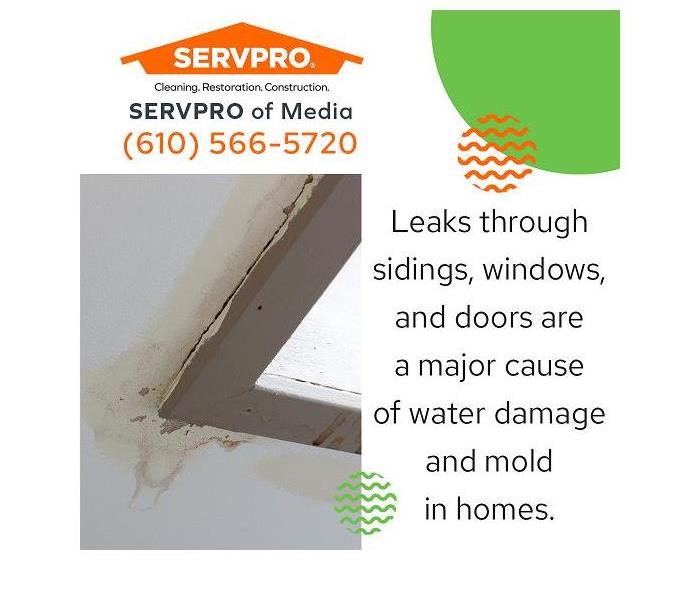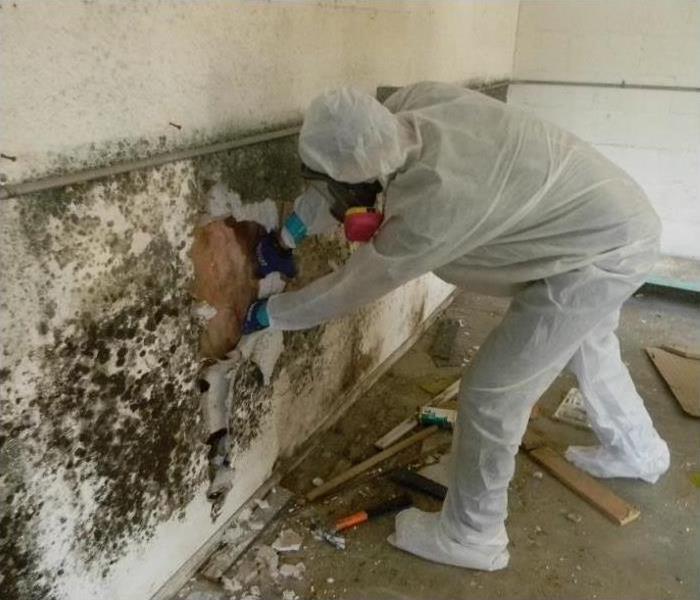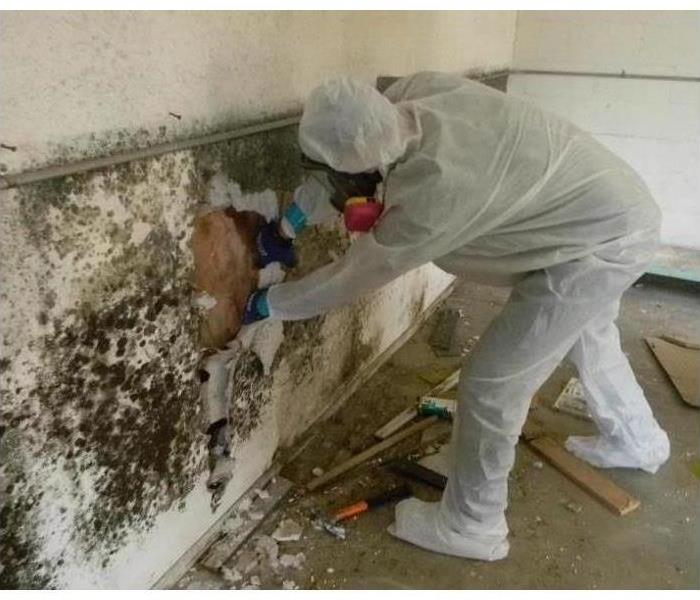Unveiling the hidden dangers of mold infestation
5/21/2024 (Permalink)
Mold infestation can pose significant risks to property integrity. Excess moisture is the primary catalyst for mold growth, creating an ideal environment for mold spores to thrive. This can occur due to roof leaks, faulty windows or pipes, flooding, or high humidity levels.
Our company is committed to ensuring that our customers understand the risks and causes of mold infestation. By providing comprehensive information on these topics, we aim to empower homeowners to take proactive measures to prevent mold growth and protect their properties.
Through informative and accessible content, we strive to establish our company as a trusted resource for mold remediation services. By addressing the concerns and questions of our audience, we can build credibility and trust, ultimately driving organic traffic to our website and generating leads for our business.
Causes of mold growth in homes
Understanding the underlying causes of mold growth in homes is essential for effective mold prevention and mold remediation strategies. Identifying these causes allows homeowners to take proactive measures to mitigate moisture issues and create a healthier indoor environment.
Sources of moisture conducive to mold growth
Mold requires moisture to thrive, making any source of water leakage or accumulation a potential catalyst for mold growth. Common sources of moisture conducive to mold growth include leaking pipes, roof leaks, condensation buildup, and flooding. Additionally, high humidity levels, inadequate ventilation, and dampness in basements or crawl spaces can create ideal conditions for mold to flourish.
Common indoor environments where mold thrives
Mold can thrive in indoor environments with elevated moisture levels and is conducive to growth. Areas such as bathrooms, kitchens, basements, and attics are particularly susceptible to mold infestation due to their frequent exposure to moisture. Additionally, areas with poor ventilation or inadequate airflow, such as closets and wall cavities, may harbor mold growth. Understanding these common environments can help homeowners effectively target their prevention and remediation efforts.
Key steps for mold remediation and removal
Mold remediation and removal are crucial for restoring indoor air quality and preventing further damage to homes and buildings. Effective remediation involves key steps to identify, contain, and eliminate mold growth while addressing the underlying moisture issues. Here are the essential steps for mold remediation and removal:
Assessment and inspection
The first step in mold remediation is to assess and inspect the affected areas thoroughly. This involves identifying the extent of mold growth, determining the underlying cause of moisture, and assessing any structural damage. Professional inspectors may use specialized equipment such as moisture meters and thermal imaging cameras to pinpoint areas of concern accurately.
Containment
Once the extent of mold growth has been determined, it's essential to contain the affected areas to prevent the spread of mold spores to uncontaminated areas. This typically involves sealing the contaminated area with plastic sheeting and using negative air pressure to direct airflow outside the building. Containment measures help minimize cross-contamination and protect occupants and workers during remediation.
Mold removal
The next step is the physical removal of mold from contaminated surfaces. Depending on the extent of the infestation and the type of materials affected, mold removal methods may vary. Non-porous surfaces can usually be cleaned and disinfected with commercial mold remediation products or a bleach solution. However, porous materials such as drywall, carpeting, and insulation may need to be removed and replaced to eliminate mold growth effectively.
Drying and dehumidification
After mold removal, the affected areas must be thoroughly dried to prevent moisture buildup and inhibit future mold growth. Industrial-grade air movers and dehumidifiers often accelerate drying and restore normal humidity levels. Proper drying is crucial for preventing mold recurrence and ensuring the long-term success of remediation efforts.
Cleaning and disinfection
Once the affected areas have been dried, they should be cleaned and disinfected to remove residual mold spores and prevent regrowth. Surfaces can be scrubbed with a detergent solution or antimicrobial cleaner to remove mold stains and surface contaminants. Following proper safety protocols and using personal protective equipment during cleaning is essential to minimize exposure to mold and cleaning agents.
Prevention strategies
Finally, implementing preventive measures is key to reducing the risk of future mold infestations. This may include repairing leaks, improving ventilation, and addressing any underlying moisture issues. Regular inspections and maintenance can help identify potential mold growth early and prevent significant damage to homes and buildings.
Homeowners and property managers can effectively address mold infestations and create a healthier indoor environment for occupants by following these key mold remediation and removal steps. For large or severe mold problems, professional assistance may be necessary to ensure thorough remediation and prevent recurrence.
Step 1: Inspection and assessment
Before proceeding with mold remediation and removal, conducting a thorough inspection and assessment of the affected areas is crucial. This initial step is essential for understanding the scope of the mold problem and developing an effective remediation plan. Here's what's involved in the inspection and assessment process:
Identifying areas of mold growth
The first task during the inspection is to identify all areas where mold is present. Mold can often be found in damp, dark, and poorly ventilated areas such as basements, bathrooms, attics, and crawl spaces. However, mold can also grow in less obvious places, such as behind walls, under flooring, and inside HVAC systems. Using specialized tools and equipment, inspectors carefully examine visible and hidden areas for signs of mold growth, including discoloration, musty odors, and moisture damage.
Assessing the extent of mold damage
Once areas of mold growth have been identified, the next step is to assess the extent of the damage. This involves determining how widespread the mold infestation is and evaluating the structural integrity of affected materials. Inspectors may use moisture meters, infrared cameras, and other diagnostic tools to measure moisture levels and identify areas of water intrusion. By understanding the full extent of the mold problem, remediation professionals can develop a comprehensive plan to address the issue effectively.
During the inspection and assessment, it's essential to document findings through photographs, written reports, and moisture readings. This documentation helps guide the remediation process and serves as a record of the conditions before and after remediation for insurance purposes and legal documentation.
By thoroughly inspecting and assessing the affected areas, remediation professionals can identify the source of moisture, determine the extent of mold growth, and develop a targeted remediation strategy to restore the indoor environment safely. This proactive approach helps ensure that mold problems are addressed comprehensively, minimizing the risk of recurrence and protecting the health and safety of occupants.
Step 2: Containment and protection
Once the areas of mold growth have been identified and assessed, the next critical step in the remediation process is containment and protection. This involves implementing measures to prevent the spread of mold spores to unaffected areas and ensuring the safety of remediation workers. Here's how containment and protection are typically addressed:
Establishing containment measures to prevent mold spore spread
Containment measures are essential for preventing mold spores from spreading to other building parts during remediation. This is achieved by isolating the affected areas to minimize cross-contamination. Containment barriers, such as plastic sheeting and tape, are erected to seal off the work area and create a controlled environment. Negative air pressure systems may also be used to vent contaminated air outside the building while preventing the escape of mold spores into surrounding areas. Additionally, air scrubbers equipped with HEPA filters help capture airborne mold spores, further reducing the risk of contamination.
Personal protective equipment (PPE) for safe remediation
Ensuring the safety of remediation workers is paramount during mold removal. Personal protective equipment (PPE) is worn to minimize exposure to mold spores and other potential hazards. This typically includes respirators, gloves, protective clothing, and eye protection. Respirators, in particular, are essential for filtering out mold spores and other airborne contaminants, protecting workers' respiratory health. PPE should be properly fitted, worn consistently, and removed safely to prevent contamination.
By implementing effective containment measures and providing adequate personal protective equipment, remediation professionals can minimize the spread of mold spores and protect the health and safety of occupants and workers. These proactive measures help create a controlled remediation environment and reduce the risk of exposure to harmful mold contaminants.
Step 3: Mold removal techniques
After containment and protection measures are in place, the focus shifts to effectively removing mold from the affected areas. Several techniques are commonly employed during mold remediation to ensure thorough removal and prevent future growth. Here are the key methods used:
Mechanical removal methods (scrubbing, brushing)
Mechanical removal involves physically scrubbing or brushing surfaces to dislodge and remove mold growth. This method is effective for non-porous materials such as tile, glass, and metal surfaces. Specialized brushes, scrubbers, and abrasive tools may agitate the mold and loosen its grip on the surface. Once dislodged, the mold debris is carefully collected and disposed of to prevent recontamination. Thorough cleaning with detergent and water helps eliminate remaining mold particles and residue.
Chemical treatments for mold removal
Chemical treatments are often used with mechanical removal methods to enhance effectiveness and ensure complete mold eradication. Mold remediation professionals may apply antimicrobial agents, fungicides, or biocides to affected surfaces to kill mold spores and inhibit future growth. These chemical treatments penetrate porous materials and reach hidden mold growth in hard-to-reach areas. It's important to follow manufacturer guidelines and safety protocols when using chemical agents to avoid exposure risks and ensure proper application.
Removal of contaminated materials
In cases of severe mold infestation or extensive damage, removing contaminated materials may be necessary to eliminate the source of mold growth. Porous materials such as drywall, insulation, carpeting, and upholstery may harbor mold colonies and are difficult to clean effectively. In such instances, these materials are safely removed and disposed of according to regulatory guidelines. Careful demolition and disposal procedures are followed to prevent the spread of mold spores and minimize environmental impact.
By employing mechanical and chemical removal techniques and safely disposing of contaminated materials, mold remediation professionals can effectively eliminate mold infestations and restore indoor environments to healthy conditions. These systematic removal methods help address visible mold growth and hidden contamination, reducing the risk of recurrence and ensuring long-term mold control.
Step 4: Cleaning and sanitization
Once the mold has been removed, thorough cleaning and sanitization of the affected areas are essential to prevent regrowth and ensure a safe indoor environment. This step involves meticulous cleaning of surfaces to remove any remaining mold particles and spores and disinfection to inhibit mold resurgence. Here's how it's typically done:
Thorough cleaning of affected surfaces
To remove any remaining mold residue, every surface affected by mold growth must be carefully cleaned. This includes walls, floors, ceilings, and other surfaces where mold was present. Specialized cleaning agents and equipment may scrub, wipe, or vacuum surfaces, effectively removing all mold particles. Thorough cleaning helps eliminate lingering odors and reduces the risk of mold recurrence.
Disinfection to prevent mold regrowth
After cleaning, the affected areas are treated with disinfectants or antimicrobial solutions to kill any remaining mold spores and prevent regrowth. Disinfection helps create an inhospitable environment for mold growth, reducing the likelihood of future infestations. Common disinfectants used in mold remediation include bleach solutions, hydrogen peroxide, and commercial antimicrobial cleaners. Surfaces are thoroughly treated and allowed to dry completely to ensure optimal effectiveness.
By conducting comprehensive cleaning and sanitization procedures, mold remediation professionals can effectively eliminate mold residue and minimize the risk of recurrence. This final step improves indoor air quality and restores the safety and integrity of the affected areas, providing occupants with peace of mind and a healthier living environment.
Step 5: Drying and dehumidification
After the cleaning and sanitization process, it's crucial to ensure that the affected areas are thoroughly dried to eliminate excess moisture. Drying and dehumidification prevent mold recurrence and maintain a healthy indoor environment. Here's how it's typically done:
Utilizing drying equipment to eliminate moisture
Professional mold remediation teams use specialized drying equipment, such as high-powered fans, dehumidifiers, and air movers, to expedite the drying process. These equipment help extract moisture from the air and surfaces, accelerating evaporation and reducing humidity levels. Thoroughly drying the affected areas eliminates any remaining moisture that could support mold growth, minimizing the risk of mold re-infestation.
Maintaining optimal humidity levels to prevent mold recurrence
In addition to drying, it's essential to maintain optimal humidity levels in the indoor environment to prevent mold from returning. Mold thrives in damp conditions, so controlling humidity is critical for mold prevention. Professionals may use hygrometers to monitor humidity levels and adjust dehumidifiers accordingly to maintain levels between 30% and 50%. Property owners can create an inhospitable environment for mold growth and safeguard against future infestations by keeping humidity in check.
By following proper drying and dehumidification procedures, mold remediation experts can eliminate moisture and create unfavorable conditions for mold growth. This final step is essential for ensuring long-term success in mold remediation and protecting the health and safety of occupants.
Step 6: Restoration and repair
Once the mold remediation process is complete, the next crucial step is restoration and repair to return the affected area to its pre-infestation condition. This involves addressing any structural damage and restoring the space's aesthetic appeal. Here's what's typically involved:
Repairing damaged structures and materials
During the mold remediation process, it's common for structures and materials to sustain damage. This could include drywall, flooring, insulation, and other building materials that may have been affected by mold growth or the remediation efforts. Repairing these damaged structures is essential for restoring the integrity of the property and ensuring its safety and stability. Professional restoration teams have the expertise and tools to assess the extent of the damage and perform necessary repairs, which may involve replacing damaged drywall, flooring, or insulation, repairing leaks or structural issues, and restoring any other affected components to their original condition.
Restoring the affected area to its pre-infestation condition
Once repairs are complete, the restoration focuses on returning the affected area to its pre-infestation state. This includes cosmetic repairs and finishing touches to ensure the space looks and functions as before the mold problem. Restoration efforts may involve painting, refinishing surfaces, replacing fixtures or finishes, and restoring any other aesthetic elements that may have been affected during the remediation process. The goal is to eliminate the mold and restore the affected area to a clean, safe, and visually appealing condition that meets the property owner's expectations.
Property owners can ensure that their spaces are fully restored and ready for occupancy by prioritizing restoration and repair following mold remediation. Professional restoration services play a crucial role in this process, providing comprehensive solutions to address structural damage and aesthetic concerns, ultimately returning the property to its preloss condition.
Preventive measures for long-term mold control
Mold prevention is key to maintaining a healthy indoor environment and preserving the integrity of your property. By implementing proactive measures, you can minimize the risk of mold growth and ensure long-term mold control.
To prevent mold growth, it's essential to maintain a healthy indoor environment that discourages moisture buildup and creates conditions unfavorable for mold. Here are some key steps:
Regular inspection for leaks and moisture accumulation
Perform routine property inspections to identify any signs of leaks or moisture accumulation. Check areas prone to water intrusion, such as plumbing fixtures, windows, doors, and roofs. Look for signs of water damage, including discoloration, staining, or peeling paint, and address any issues promptly to prevent moisture from promoting mold growth. By identifying and repairing leaks early on, you can prevent water from infiltrating your property and creating conducive conditions for mold.
Proper ventilation to minimize humidity levels
Proper ventilation is essential for controlling indoor humidity levels and reducing the risk of mold growth. Ensure your property is adequately ventilated, especially in areas prone to moisture buildup, such as bathrooms, kitchens, and basements. Use exhaust fans to vent moisture outside and promote air circulation. Additionally, consider using dehumidifiers in high-humidity areas to maintain optimal moisture levels and prevent mold from thriving in damp environments. By improving ventilation and reducing humidity, you can create an inhospitable environment for mold growth, helping to protect your property from mold-related issues in the long term.
By proactively maintaining your indoor environment and implementing preventive measures, you can effectively control mold growth and minimize the risk of mold-related problems. Regular inspections, proper ventilation, and moisture management are essential components of a comprehensive mold prevention strategy, helping to safeguard your property and ensure a healthy living environment for occupants.
Implementing preventive measures
Preventing mold growth requires proactive measures and a commitment to maintaining a healthy indoor environment. Preventive measures can help mitigate the risk of mold infestation and protect your property. Here are some effective strategies:
Using mold-resistant materials in construction and renovation
When constructing or renovating a property, consider using mold-resistant materials to minimize the likelihood of mold growth. Opt for building materials specifically designed to resist moisture and mold, such as mold-resistant drywall, paint, and insulation. These materials are formulated to inhibit mold growth and provide a layer of protection against moisture intrusion. By incorporating mold-resistant materials into your property, you can reduce the risk of mold infestation and ensure long-term durability.
Educating residents on mold prevention practices
Educating residents on mold prevention practices is essential for maintaining a mold-free environment. Provide information and guidance on proper moisture management, ventilation techniques, and regular inspection protocols. Encourage residents to promptly report any signs of water damage or mold growth and emphasize the importance of addressing these issues promptly. Additionally, it offers tips on maintaining indoor humidity levels, such as using exhaust fans in bathrooms and kitchens and dehumidifiers in damp areas. Empowering residents with knowledge and resources can foster a proactive approach to mold prevention and create a collaborative effort to safeguard the property against mold-related problems.
By implementing these preventive measures, you can create a proactive mold prevention strategy that minimizes the risk of mold growth and protects your property from mold-related issues. Utilizing mold-resistant materials and educating residents on mold prevention practices are key components of an effective mold prevention plan, helping to ensure a healthy and mold-free environment for occupants.
Taking action against mold infestation
Empowering individuals with knowledge and resources
Empowering individuals with mold prevention and remediation knowledge is crucial for proactive action against mold infestation. Individuals can proactively protect themselves and their properties from mold-related problems by providing educational resources and guidance on identifying and addressing mold issues.
Encouraging proactive measures for mold prevention
Encouraging proactive measures for mold prevention is key to ensuring a mold-free environment in the long term. By implementing preventive strategies, such as maintaining proper ventilation, controlling humidity levels, and using mold-resistant materials, individuals can reduce the likelihood of mold growth and create a healthier living or working environment for
Individuals and property owners can create a mold-free environment that promotes health, safety, and well-being by prioritizing prompt and effective mold remediation measures and taking proactive steps to prevent mold growth.
Conclusion: Ensuring a mold-free environment
In conclusion, maintaining a mold-free environment is crucial for safeguarding both occupants' health and properties' structural integrity. By prioritizing prompt and effective mold remediation measures, individuals and property owners can mitigate the risks associated with mold.
Prompt and effective mold remediation is essential for protecting the health and well-being of occupants. Mold exposure can lead to various health issues, ranging from mild allergic reactions to severe respiratory problems. By addressing mold infestation promptly and thoroughly, individuals can minimize the risk of adverse health effects and create a healthier indoor environment for themselves and their families.
In addition to protecting human health, prompt mold remediation also helps preserve properties' structural integrity. If left unchecked, mold can cause significant damage to building materials, including wood, drywall, and insulation. By removing mold promptly and addressing underlying moisture issues, property owners can prevent structural damage and avoid costly repairs in the future.
SERVPRO® of Central Delaware County
Regarding mold cleanup, SERVPRO of Media and SERVPRO of Central Delaware County are your trusted partners. With years of experience in the restoration industry, our teams are equipped to handle mold remediation projects of any size. Whether dealing with a minor mold issue or a major infestation, our certified technicians use advanced techniques and equipment to safely and effectively remove mold from your property. Don't let mold jeopardize your health and property—contact SERVPRO of Central Delaware County at (610) 566-5720 today for professional mold cleanup services. Take action now and restore your property to a safe and healthy condition.





 24/7 Emergency Service
24/7 Emergency Service





